Corporate Law Case Study Assignment - Semester 1, 2024
VerifiedAdded on 2022/11/17
|11
|3005
|372
Case Study
AI Summary
This case study assignment delves into the legal concept of piercing the corporate veil, a critical aspect of corporate law. It begins by referencing the landmark case of Salomon v Salomon & Co, which established the separate legal entity of a company. The assignment then explores the evolution of the 'piercing corporate veil' doctrine, citing cases like Brewarrana v Commissioner of Highways and Walker v Hungerfords, and highlighting the circumstances under which courts may disregard the corporate entity. It examines cases such as Lee v Lee’s Air Farming Ltd and MacLeod v The Queen to illustrate how courts apply the doctrine in practice, including instances of fraud, agency, sham, unfairness, and group enterprises. The assignment further discusses the advantages of incorporation, such as limited liability, and the exceptions where this protection can be removed. It also covers statutory provisions, like those related to insolvent trading under the Corporations Act 2001 (Cth), which allow for piercing the veil to hold directors liable for company debts. The study concludes by outlining the five main reasons for limited liability and provides a detailed analysis of various grounds for piercing the corporate veil, including fraud, agency, sham, unfairness, and group enterprises, supported by relevant case law.
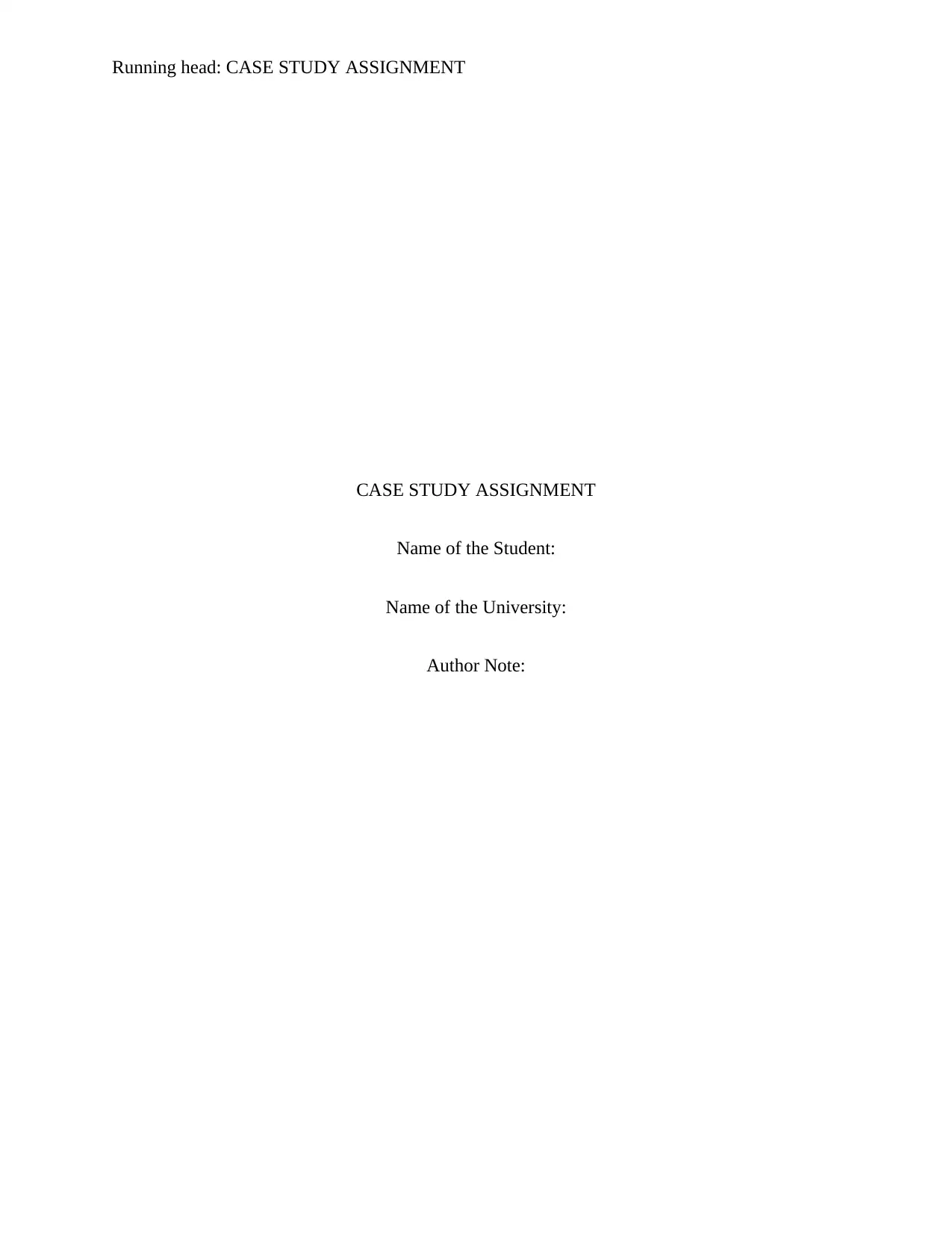
Running head: CASE STUDY ASSIGNMENT
CASE STUDY ASSIGNMENT
Name of the Student:
Name of the University:
Author Note:
CASE STUDY ASSIGNMENT
Name of the Student:
Name of the University:
Author Note:
Paraphrase This Document
Need a fresh take? Get an instant paraphrase of this document with our AI Paraphraser
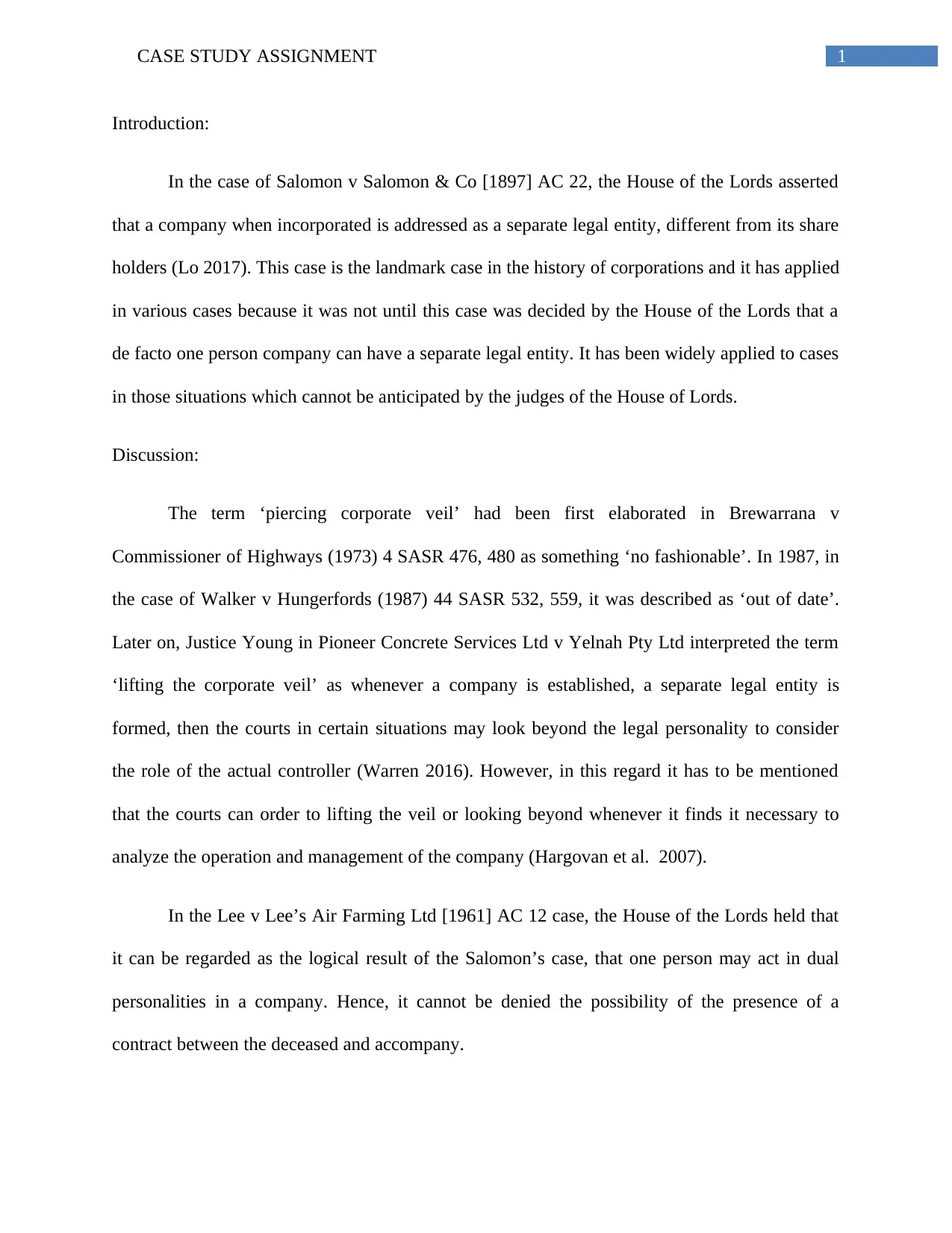
1CASE STUDY ASSIGNMENT
Introduction:
In the case of Salomon v Salomon & Co [1897] AC 22, the House of the Lords asserted
that a company when incorporated is addressed as a separate legal entity, different from its share
holders (Lo 2017). This case is the landmark case in the history of corporations and it has applied
in various cases because it was not until this case was decided by the House of the Lords that a
de facto one person company can have a separate legal entity. It has been widely applied to cases
in those situations which cannot be anticipated by the judges of the House of Lords.
Discussion:
The term ‘piercing corporate veil’ had been first elaborated in Brewarrana v
Commissioner of Highways (1973) 4 SASR 476, 480 as something ‘no fashionable’. In 1987, in
the case of Walker v Hungerfords (1987) 44 SASR 532, 559, it was described as ‘out of date’.
Later on, Justice Young in Pioneer Concrete Services Ltd v Yelnah Pty Ltd interpreted the term
‘lifting the corporate veil’ as whenever a company is established, a separate legal entity is
formed, then the courts in certain situations may look beyond the legal personality to consider
the role of the actual controller (Warren 2016). However, in this regard it has to be mentioned
that the courts can order to lifting the veil or looking beyond whenever it finds it necessary to
analyze the operation and management of the company (Hargovan et al. 2007).
In the Lee v Lee’s Air Farming Ltd [1961] AC 12 case, the House of the Lords held that
it can be regarded as the logical result of the Salomon’s case, that one person may act in dual
personalities in a company. Hence, it cannot be denied the possibility of the presence of a
contract between the deceased and accompany.
Introduction:
In the case of Salomon v Salomon & Co [1897] AC 22, the House of the Lords asserted
that a company when incorporated is addressed as a separate legal entity, different from its share
holders (Lo 2017). This case is the landmark case in the history of corporations and it has applied
in various cases because it was not until this case was decided by the House of the Lords that a
de facto one person company can have a separate legal entity. It has been widely applied to cases
in those situations which cannot be anticipated by the judges of the House of Lords.
Discussion:
The term ‘piercing corporate veil’ had been first elaborated in Brewarrana v
Commissioner of Highways (1973) 4 SASR 476, 480 as something ‘no fashionable’. In 1987, in
the case of Walker v Hungerfords (1987) 44 SASR 532, 559, it was described as ‘out of date’.
Later on, Justice Young in Pioneer Concrete Services Ltd v Yelnah Pty Ltd interpreted the term
‘lifting the corporate veil’ as whenever a company is established, a separate legal entity is
formed, then the courts in certain situations may look beyond the legal personality to consider
the role of the actual controller (Warren 2016). However, in this regard it has to be mentioned
that the courts can order to lifting the veil or looking beyond whenever it finds it necessary to
analyze the operation and management of the company (Hargovan et al. 2007).
In the Lee v Lee’s Air Farming Ltd [1961] AC 12 case, the House of the Lords held that
it can be regarded as the logical result of the Salomon’s case, that one person may act in dual
personalities in a company. Hence, it cannot be denied the possibility of the presence of a
contract between the deceased and accompany.
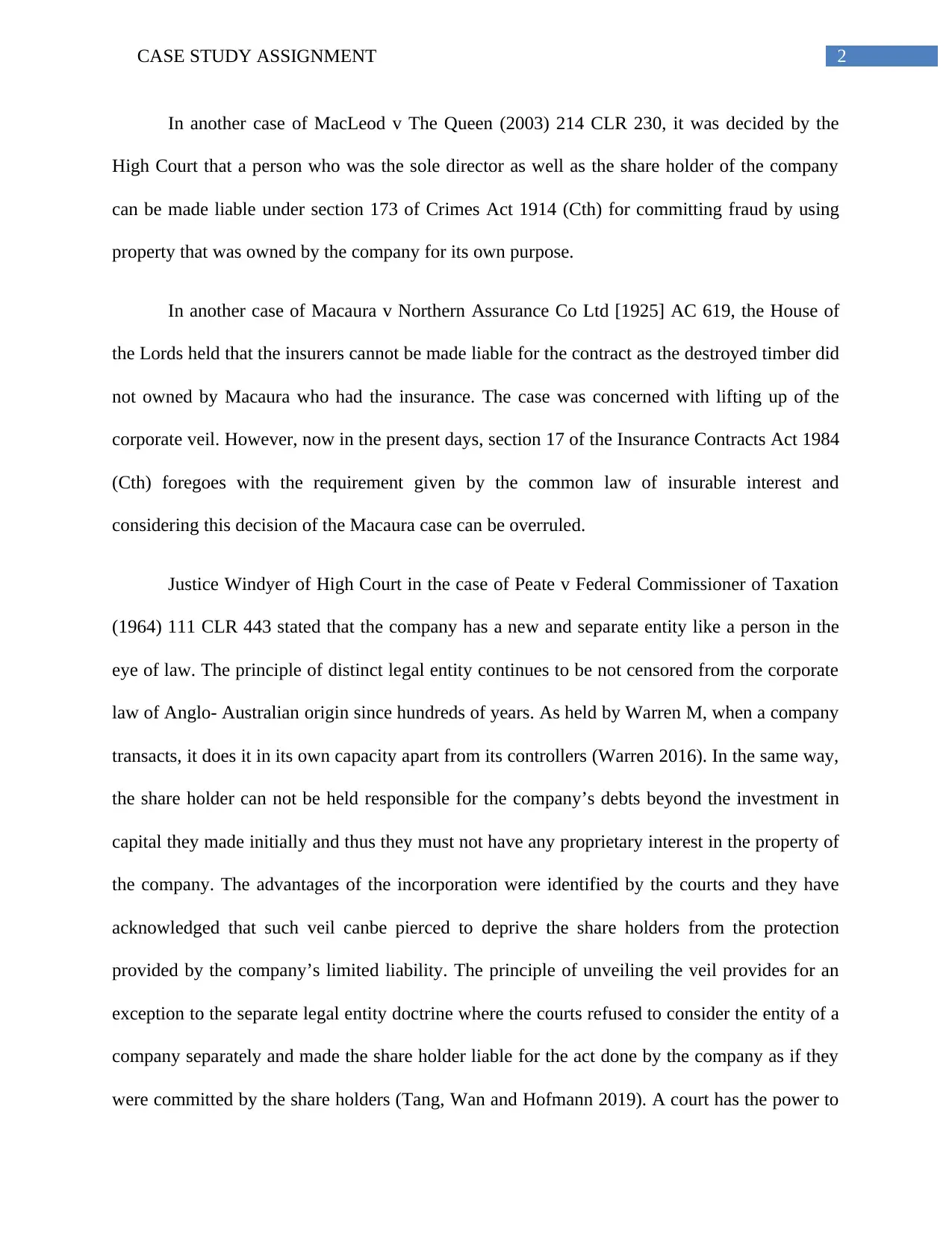
2CASE STUDY ASSIGNMENT
In another case of MacLeod v The Queen (2003) 214 CLR 230, it was decided by the
High Court that a person who was the sole director as well as the share holder of the company
can be made liable under section 173 of Crimes Act 1914 (Cth) for committing fraud by using
property that was owned by the company for its own purpose.
In another case of Macaura v Northern Assurance Co Ltd [1925] AC 619, the House of
the Lords held that the insurers cannot be made liable for the contract as the destroyed timber did
not owned by Macaura who had the insurance. The case was concerned with lifting up of the
corporate veil. However, now in the present days, section 17 of the Insurance Contracts Act 1984
(Cth) foregoes with the requirement given by the common law of insurable interest and
considering this decision of the Macaura case can be overruled.
Justice Windyer of High Court in the case of Peate v Federal Commissioner of Taxation
(1964) 111 CLR 443 stated that the company has a new and separate entity like a person in the
eye of law. The principle of distinct legal entity continues to be not censored from the corporate
law of Anglo- Australian origin since hundreds of years. As held by Warren M, when a company
transacts, it does it in its own capacity apart from its controllers (Warren 2016). In the same way,
the share holder can not be held responsible for the company’s debts beyond the investment in
capital they made initially and thus they must not have any proprietary interest in the property of
the company. The advantages of the incorporation were identified by the courts and they have
acknowledged that such veil canbe pierced to deprive the share holders from the protection
provided by the company’s limited liability. The principle of unveiling the veil provides for an
exception to the separate legal entity doctrine where the courts refused to consider the entity of a
company separately and made the share holder liable for the act done by the company as if they
were committed by the share holders (Tang, Wan and Hofmann 2019). A court has the power to
In another case of MacLeod v The Queen (2003) 214 CLR 230, it was decided by the
High Court that a person who was the sole director as well as the share holder of the company
can be made liable under section 173 of Crimes Act 1914 (Cth) for committing fraud by using
property that was owned by the company for its own purpose.
In another case of Macaura v Northern Assurance Co Ltd [1925] AC 619, the House of
the Lords held that the insurers cannot be made liable for the contract as the destroyed timber did
not owned by Macaura who had the insurance. The case was concerned with lifting up of the
corporate veil. However, now in the present days, section 17 of the Insurance Contracts Act 1984
(Cth) foregoes with the requirement given by the common law of insurable interest and
considering this decision of the Macaura case can be overruled.
Justice Windyer of High Court in the case of Peate v Federal Commissioner of Taxation
(1964) 111 CLR 443 stated that the company has a new and separate entity like a person in the
eye of law. The principle of distinct legal entity continues to be not censored from the corporate
law of Anglo- Australian origin since hundreds of years. As held by Warren M, when a company
transacts, it does it in its own capacity apart from its controllers (Warren 2016). In the same way,
the share holder can not be held responsible for the company’s debts beyond the investment in
capital they made initially and thus they must not have any proprietary interest in the property of
the company. The advantages of the incorporation were identified by the courts and they have
acknowledged that such veil canbe pierced to deprive the share holders from the protection
provided by the company’s limited liability. The principle of unveiling the veil provides for an
exception to the separate legal entity doctrine where the courts refused to consider the entity of a
company separately and made the share holder liable for the act done by the company as if they
were committed by the share holders (Tang, Wan and Hofmann 2019). A court has the power to
⊘ This is a preview!⊘
Do you want full access?
Subscribe today to unlock all pages.

Trusted by 1+ million students worldwide
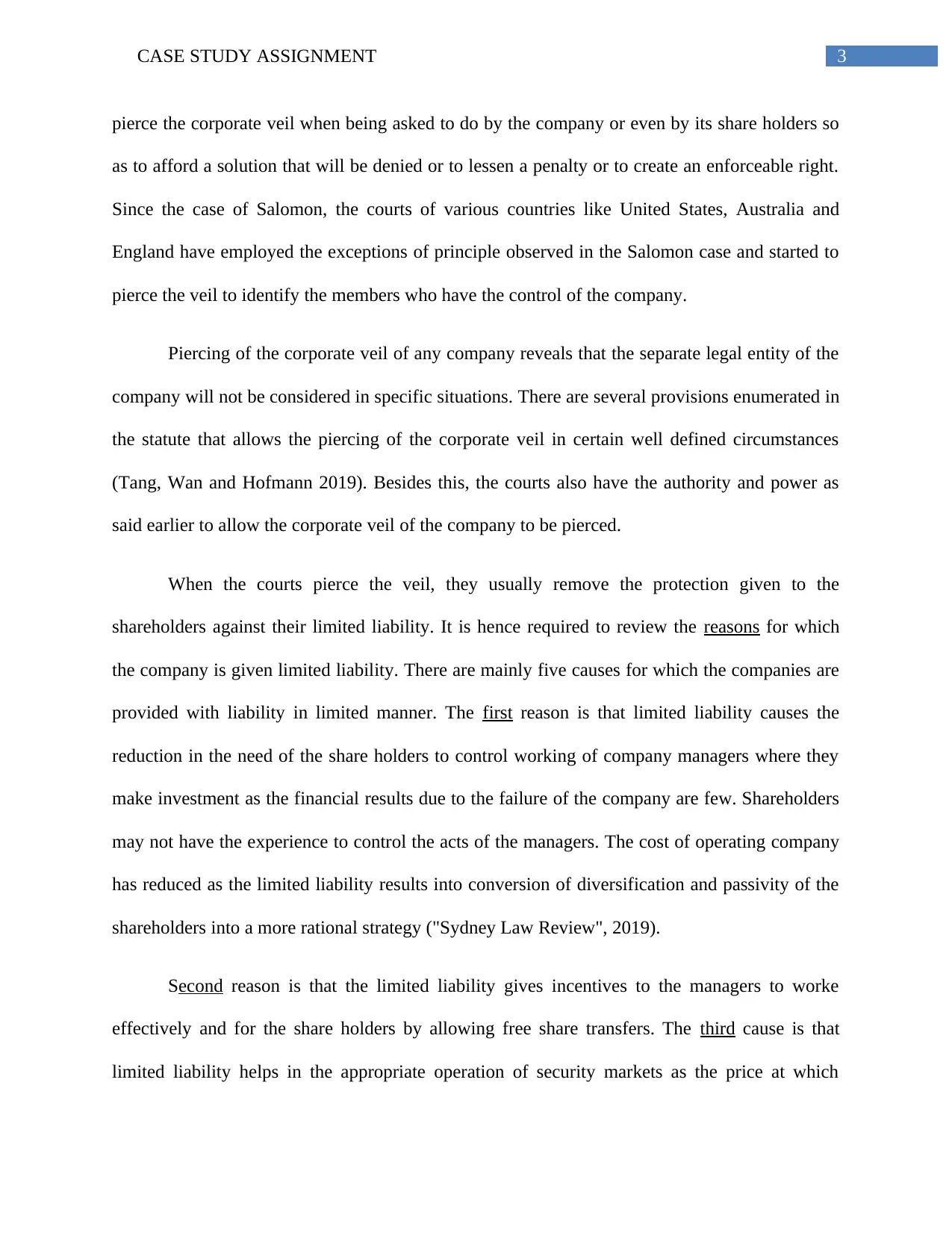
3CASE STUDY ASSIGNMENT
pierce the corporate veil when being asked to do by the company or even by its share holders so
as to afford a solution that will be denied or to lessen a penalty or to create an enforceable right.
Since the case of Salomon, the courts of various countries like United States, Australia and
England have employed the exceptions of principle observed in the Salomon case and started to
pierce the veil to identify the members who have the control of the company.
Piercing of the corporate veil of any company reveals that the separate legal entity of the
company will not be considered in specific situations. There are several provisions enumerated in
the statute that allows the piercing of the corporate veil in certain well defined circumstances
(Tang, Wan and Hofmann 2019). Besides this, the courts also have the authority and power as
said earlier to allow the corporate veil of the company to be pierced.
When the courts pierce the veil, they usually remove the protection given to the
shareholders against their limited liability. It is hence required to review the reasons for which
the company is given limited liability. There are mainly five causes for which the companies are
provided with liability in limited manner. The first reason is that limited liability causes the
reduction in the need of the share holders to control working of company managers where they
make investment as the financial results due to the failure of the company are few. Shareholders
may not have the experience to control the acts of the managers. The cost of operating company
has reduced as the limited liability results into conversion of diversification and passivity of the
shareholders into a more rational strategy ("Sydney Law Review", 2019).
Second reason is that the limited liability gives incentives to the managers to worke
effectively and for the share holders by allowing free share transfers. The third cause is that
limited liability helps in the appropriate operation of security markets as the price at which
pierce the corporate veil when being asked to do by the company or even by its share holders so
as to afford a solution that will be denied or to lessen a penalty or to create an enforceable right.
Since the case of Salomon, the courts of various countries like United States, Australia and
England have employed the exceptions of principle observed in the Salomon case and started to
pierce the veil to identify the members who have the control of the company.
Piercing of the corporate veil of any company reveals that the separate legal entity of the
company will not be considered in specific situations. There are several provisions enumerated in
the statute that allows the piercing of the corporate veil in certain well defined circumstances
(Tang, Wan and Hofmann 2019). Besides this, the courts also have the authority and power as
said earlier to allow the corporate veil of the company to be pierced.
When the courts pierce the veil, they usually remove the protection given to the
shareholders against their limited liability. It is hence required to review the reasons for which
the company is given limited liability. There are mainly five causes for which the companies are
provided with liability in limited manner. The first reason is that limited liability causes the
reduction in the need of the share holders to control working of company managers where they
make investment as the financial results due to the failure of the company are few. Shareholders
may not have the experience to control the acts of the managers. The cost of operating company
has reduced as the limited liability results into conversion of diversification and passivity of the
shareholders into a more rational strategy ("Sydney Law Review", 2019).
Second reason is that the limited liability gives incentives to the managers to worke
effectively and for the share holders by allowing free share transfers. The third cause is that
limited liability helps in the appropriate operation of security markets as the price at which
Paraphrase This Document
Need a fresh take? Get an instant paraphrase of this document with our AI Paraphraser
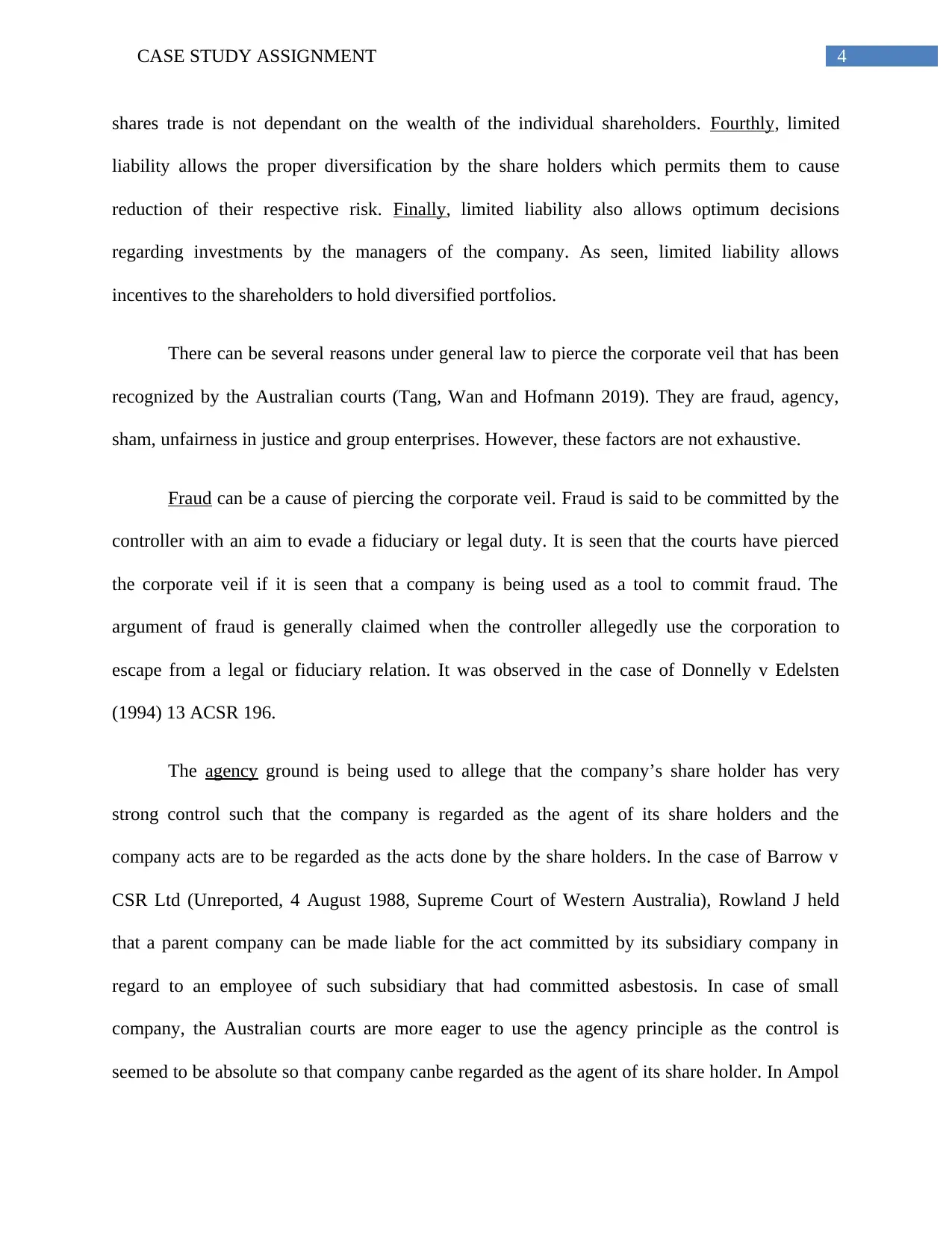
4CASE STUDY ASSIGNMENT
shares trade is not dependant on the wealth of the individual shareholders. Fourthly, limited
liability allows the proper diversification by the share holders which permits them to cause
reduction of their respective risk. Finally, limited liability also allows optimum decisions
regarding investments by the managers of the company. As seen, limited liability allows
incentives to the shareholders to hold diversified portfolios.
There can be several reasons under general law to pierce the corporate veil that has been
recognized by the Australian courts (Tang, Wan and Hofmann 2019). They are fraud, agency,
sham, unfairness in justice and group enterprises. However, these factors are not exhaustive.
Fraud can be a cause of piercing the corporate veil. Fraud is said to be committed by the
controller with an aim to evade a fiduciary or legal duty. It is seen that the courts have pierced
the corporate veil if it is seen that a company is being used as a tool to commit fraud. The
argument of fraud is generally claimed when the controller allegedly use the corporation to
escape from a legal or fiduciary relation. It was observed in the case of Donnelly v Edelsten
(1994) 13 ACSR 196.
The agency ground is being used to allege that the company’s share holder has very
strong control such that the company is regarded as the agent of its share holders and the
company acts are to be regarded as the acts done by the share holders. In the case of Barrow v
CSR Ltd (Unreported, 4 August 1988, Supreme Court of Western Australia), Rowland J held
that a parent company can be made liable for the act committed by its subsidiary company in
regard to an employee of such subsidiary that had committed asbestosis. In case of small
company, the Australian courts are more eager to use the agency principle as the control is
seemed to be absolute so that company canbe regarded as the agent of its share holder. In Ampol
shares trade is not dependant on the wealth of the individual shareholders. Fourthly, limited
liability allows the proper diversification by the share holders which permits them to cause
reduction of their respective risk. Finally, limited liability also allows optimum decisions
regarding investments by the managers of the company. As seen, limited liability allows
incentives to the shareholders to hold diversified portfolios.
There can be several reasons under general law to pierce the corporate veil that has been
recognized by the Australian courts (Tang, Wan and Hofmann 2019). They are fraud, agency,
sham, unfairness in justice and group enterprises. However, these factors are not exhaustive.
Fraud can be a cause of piercing the corporate veil. Fraud is said to be committed by the
controller with an aim to evade a fiduciary or legal duty. It is seen that the courts have pierced
the corporate veil if it is seen that a company is being used as a tool to commit fraud. The
argument of fraud is generally claimed when the controller allegedly use the corporation to
escape from a legal or fiduciary relation. It was observed in the case of Donnelly v Edelsten
(1994) 13 ACSR 196.
The agency ground is being used to allege that the company’s share holder has very
strong control such that the company is regarded as the agent of its share holders and the
company acts are to be regarded as the acts done by the share holders. In the case of Barrow v
CSR Ltd (Unreported, 4 August 1988, Supreme Court of Western Australia), Rowland J held
that a parent company can be made liable for the act committed by its subsidiary company in
regard to an employee of such subsidiary that had committed asbestosis. In case of small
company, the Australian courts are more eager to use the agency principle as the control is
seemed to be absolute so that company canbe regarded as the agent of its share holder. In Ampol
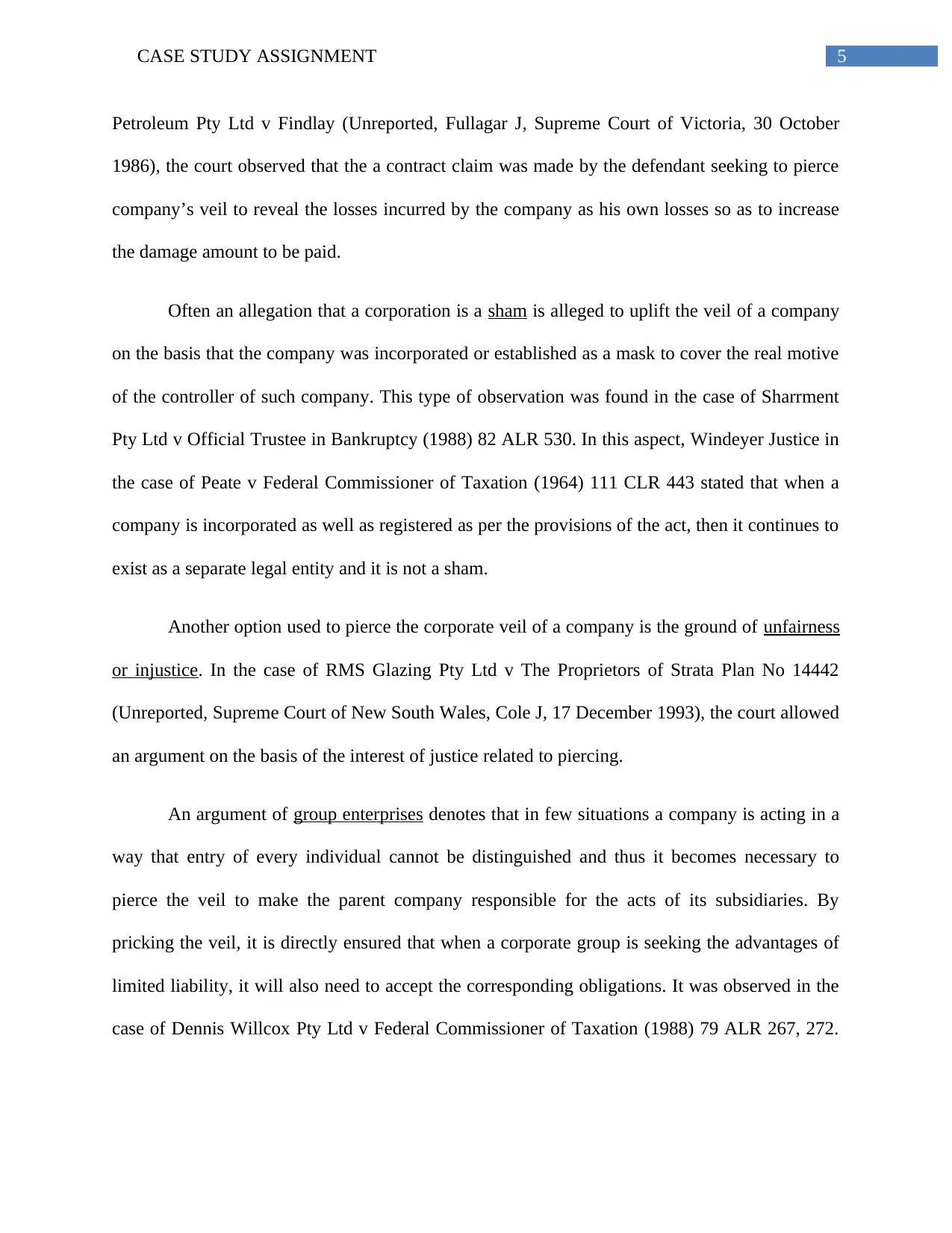
5CASE STUDY ASSIGNMENT
Petroleum Pty Ltd v Findlay (Unreported, Fullagar J, Supreme Court of Victoria, 30 October
1986), the court observed that the a contract claim was made by the defendant seeking to pierce
company’s veil to reveal the losses incurred by the company as his own losses so as to increase
the damage amount to be paid.
Often an allegation that a corporation is a sham is alleged to uplift the veil of a company
on the basis that the company was incorporated or established as a mask to cover the real motive
of the controller of such company. This type of observation was found in the case of Sharrment
Pty Ltd v Official Trustee in Bankruptcy (1988) 82 ALR 530. In this aspect, Windeyer Justice in
the case of Peate v Federal Commissioner of Taxation (1964) 111 CLR 443 stated that when a
company is incorporated as well as registered as per the provisions of the act, then it continues to
exist as a separate legal entity and it is not a sham.
Another option used to pierce the corporate veil of a company is the ground of unfairness
or injustice. In the case of RMS Glazing Pty Ltd v The Proprietors of Strata Plan No 14442
(Unreported, Supreme Court of New South Wales, Cole J, 17 December 1993), the court allowed
an argument on the basis of the interest of justice related to piercing.
An argument of group enterprises denotes that in few situations a company is acting in a
way that entry of every individual cannot be distinguished and thus it becomes necessary to
pierce the veil to make the parent company responsible for the acts of its subsidiaries. By
pricking the veil, it is directly ensured that when a corporate group is seeking the advantages of
limited liability, it will also need to accept the corresponding obligations. It was observed in the
case of Dennis Willcox Pty Ltd v Federal Commissioner of Taxation (1988) 79 ALR 267, 272.
Petroleum Pty Ltd v Findlay (Unreported, Fullagar J, Supreme Court of Victoria, 30 October
1986), the court observed that the a contract claim was made by the defendant seeking to pierce
company’s veil to reveal the losses incurred by the company as his own losses so as to increase
the damage amount to be paid.
Often an allegation that a corporation is a sham is alleged to uplift the veil of a company
on the basis that the company was incorporated or established as a mask to cover the real motive
of the controller of such company. This type of observation was found in the case of Sharrment
Pty Ltd v Official Trustee in Bankruptcy (1988) 82 ALR 530. In this aspect, Windeyer Justice in
the case of Peate v Federal Commissioner of Taxation (1964) 111 CLR 443 stated that when a
company is incorporated as well as registered as per the provisions of the act, then it continues to
exist as a separate legal entity and it is not a sham.
Another option used to pierce the corporate veil of a company is the ground of unfairness
or injustice. In the case of RMS Glazing Pty Ltd v The Proprietors of Strata Plan No 14442
(Unreported, Supreme Court of New South Wales, Cole J, 17 December 1993), the court allowed
an argument on the basis of the interest of justice related to piercing.
An argument of group enterprises denotes that in few situations a company is acting in a
way that entry of every individual cannot be distinguished and thus it becomes necessary to
pierce the veil to make the parent company responsible for the acts of its subsidiaries. By
pricking the veil, it is directly ensured that when a corporate group is seeking the advantages of
limited liability, it will also need to accept the corresponding obligations. It was observed in the
case of Dennis Willcox Pty Ltd v Federal Commissioner of Taxation (1988) 79 ALR 267, 272.
⊘ This is a preview!⊘
Do you want full access?
Subscribe today to unlock all pages.

Trusted by 1+ million students worldwide
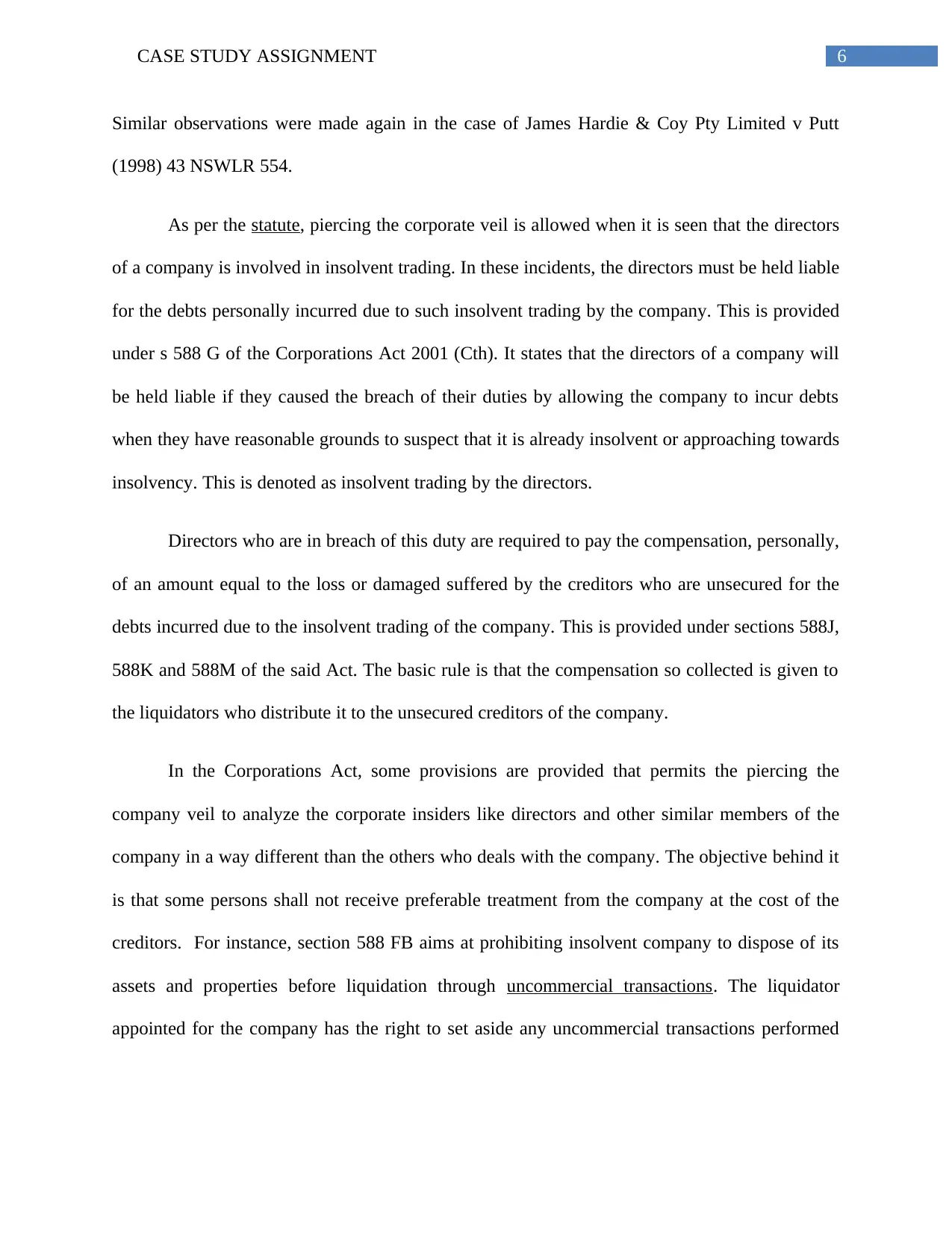
6CASE STUDY ASSIGNMENT
Similar observations were made again in the case of James Hardie & Coy Pty Limited v Putt
(1998) 43 NSWLR 554.
As per the statute, piercing the corporate veil is allowed when it is seen that the directors
of a company is involved in insolvent trading. In these incidents, the directors must be held liable
for the debts personally incurred due to such insolvent trading by the company. This is provided
under s 588 G of the Corporations Act 2001 (Cth). It states that the directors of a company will
be held liable if they caused the breach of their duties by allowing the company to incur debts
when they have reasonable grounds to suspect that it is already insolvent or approaching towards
insolvency. This is denoted as insolvent trading by the directors.
Directors who are in breach of this duty are required to pay the compensation, personally,
of an amount equal to the loss or damaged suffered by the creditors who are unsecured for the
debts incurred due to the insolvent trading of the company. This is provided under sections 588J,
588K and 588M of the said Act. The basic rule is that the compensation so collected is given to
the liquidators who distribute it to the unsecured creditors of the company.
In the Corporations Act, some provisions are provided that permits the piercing the
company veil to analyze the corporate insiders like directors and other similar members of the
company in a way different than the others who deals with the company. The objective behind it
is that some persons shall not receive preferable treatment from the company at the cost of the
creditors. For instance, section 588 FB aims at prohibiting insolvent company to dispose of its
assets and properties before liquidation through uncommercial transactions. The liquidator
appointed for the company has the right to set aside any uncommercial transactions performed
Similar observations were made again in the case of James Hardie & Coy Pty Limited v Putt
(1998) 43 NSWLR 554.
As per the statute, piercing the corporate veil is allowed when it is seen that the directors
of a company is involved in insolvent trading. In these incidents, the directors must be held liable
for the debts personally incurred due to such insolvent trading by the company. This is provided
under s 588 G of the Corporations Act 2001 (Cth). It states that the directors of a company will
be held liable if they caused the breach of their duties by allowing the company to incur debts
when they have reasonable grounds to suspect that it is already insolvent or approaching towards
insolvency. This is denoted as insolvent trading by the directors.
Directors who are in breach of this duty are required to pay the compensation, personally,
of an amount equal to the loss or damaged suffered by the creditors who are unsecured for the
debts incurred due to the insolvent trading of the company. This is provided under sections 588J,
588K and 588M of the said Act. The basic rule is that the compensation so collected is given to
the liquidators who distribute it to the unsecured creditors of the company.
In the Corporations Act, some provisions are provided that permits the piercing the
company veil to analyze the corporate insiders like directors and other similar members of the
company in a way different than the others who deals with the company. The objective behind it
is that some persons shall not receive preferable treatment from the company at the cost of the
creditors. For instance, section 588 FB aims at prohibiting insolvent company to dispose of its
assets and properties before liquidation through uncommercial transactions. The liquidator
appointed for the company has the right to set aside any uncommercial transactions performed
Paraphrase This Document
Need a fresh take? Get an instant paraphrase of this document with our AI Paraphraser
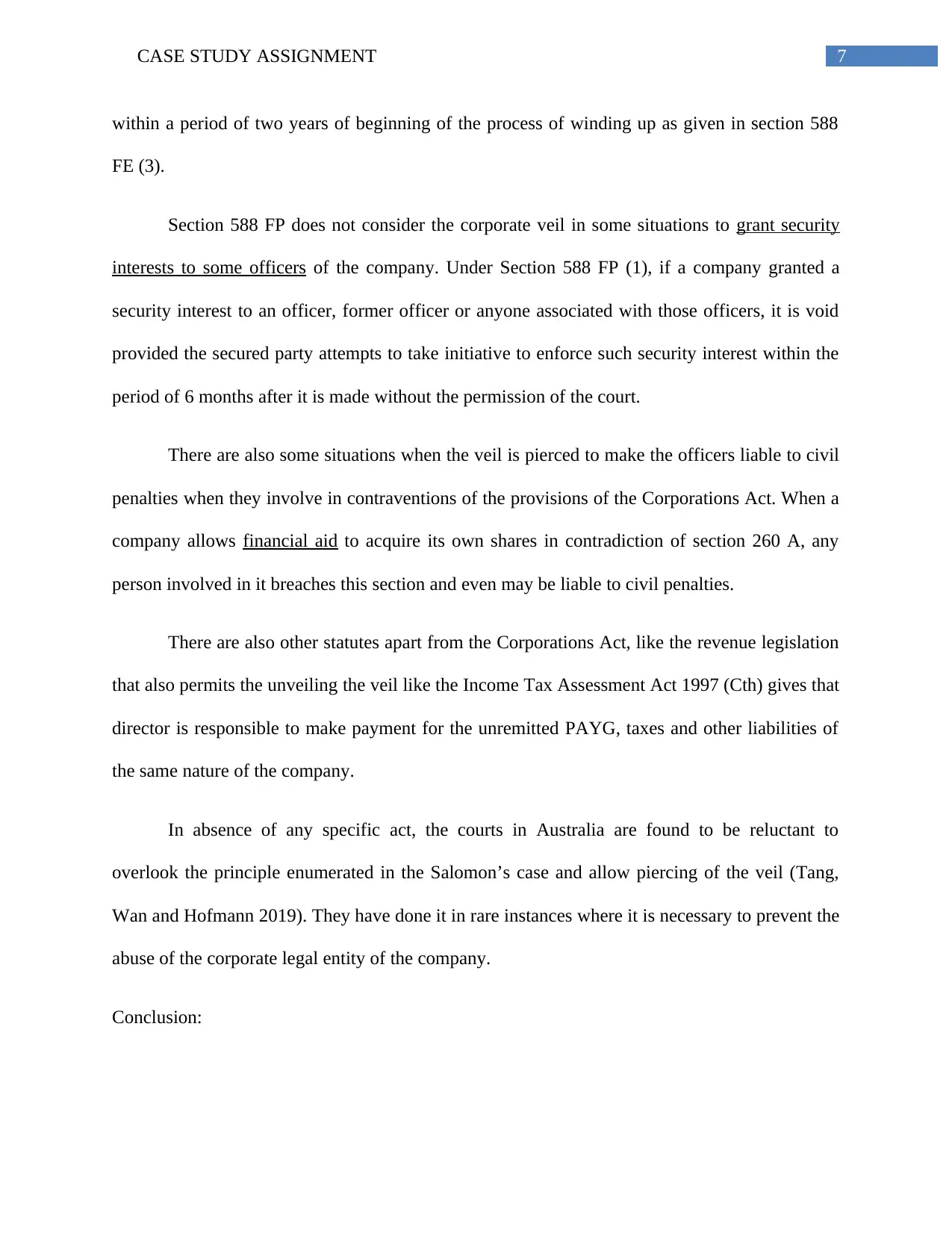
7CASE STUDY ASSIGNMENT
within a period of two years of beginning of the process of winding up as given in section 588
FE (3).
Section 588 FP does not consider the corporate veil in some situations to grant security
interests to some officers of the company. Under Section 588 FP (1), if a company granted a
security interest to an officer, former officer or anyone associated with those officers, it is void
provided the secured party attempts to take initiative to enforce such security interest within the
period of 6 months after it is made without the permission of the court.
There are also some situations when the veil is pierced to make the officers liable to civil
penalties when they involve in contraventions of the provisions of the Corporations Act. When a
company allows financial aid to acquire its own shares in contradiction of section 260 A, any
person involved in it breaches this section and even may be liable to civil penalties.
There are also other statutes apart from the Corporations Act, like the revenue legislation
that also permits the unveiling the veil like the Income Tax Assessment Act 1997 (Cth) gives that
director is responsible to make payment for the unremitted PAYG, taxes and other liabilities of
the same nature of the company.
In absence of any specific act, the courts in Australia are found to be reluctant to
overlook the principle enumerated in the Salomon’s case and allow piercing of the veil (Tang,
Wan and Hofmann 2019). They have done it in rare instances where it is necessary to prevent the
abuse of the corporate legal entity of the company.
Conclusion:
within a period of two years of beginning of the process of winding up as given in section 588
FE (3).
Section 588 FP does not consider the corporate veil in some situations to grant security
interests to some officers of the company. Under Section 588 FP (1), if a company granted a
security interest to an officer, former officer or anyone associated with those officers, it is void
provided the secured party attempts to take initiative to enforce such security interest within the
period of 6 months after it is made without the permission of the court.
There are also some situations when the veil is pierced to make the officers liable to civil
penalties when they involve in contraventions of the provisions of the Corporations Act. When a
company allows financial aid to acquire its own shares in contradiction of section 260 A, any
person involved in it breaches this section and even may be liable to civil penalties.
There are also other statutes apart from the Corporations Act, like the revenue legislation
that also permits the unveiling the veil like the Income Tax Assessment Act 1997 (Cth) gives that
director is responsible to make payment for the unremitted PAYG, taxes and other liabilities of
the same nature of the company.
In absence of any specific act, the courts in Australia are found to be reluctant to
overlook the principle enumerated in the Salomon’s case and allow piercing of the veil (Tang,
Wan and Hofmann 2019). They have done it in rare instances where it is necessary to prevent the
abuse of the corporate legal entity of the company.
Conclusion:
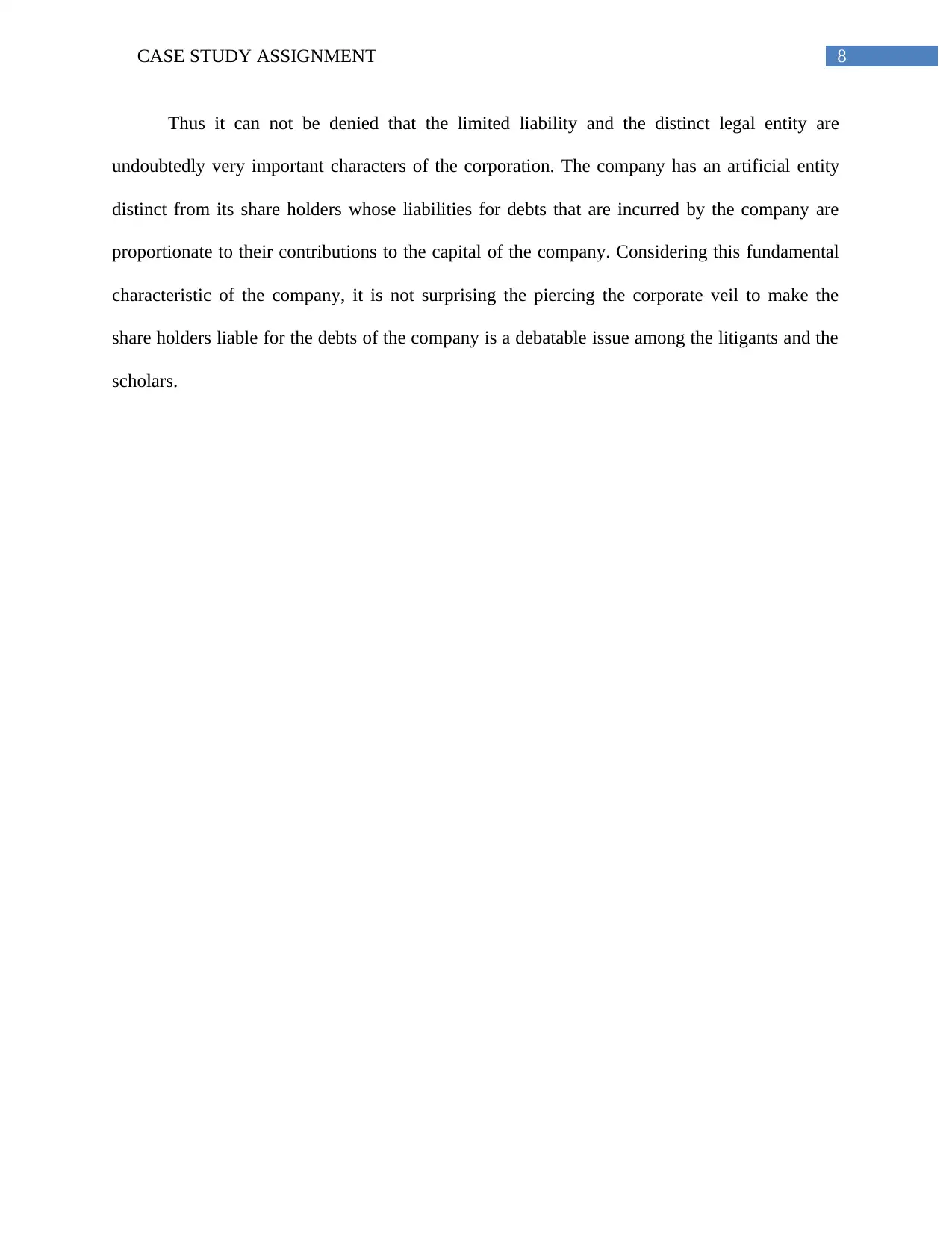
8CASE STUDY ASSIGNMENT
Thus it can not be denied that the limited liability and the distinct legal entity are
undoubtedly very important characters of the corporation. The company has an artificial entity
distinct from its share holders whose liabilities for debts that are incurred by the company are
proportionate to their contributions to the capital of the company. Considering this fundamental
characteristic of the company, it is not surprising the piercing the corporate veil to make the
share holders liable for the debts of the company is a debatable issue among the litigants and the
scholars.
Thus it can not be denied that the limited liability and the distinct legal entity are
undoubtedly very important characters of the corporation. The company has an artificial entity
distinct from its share holders whose liabilities for debts that are incurred by the company are
proportionate to their contributions to the capital of the company. Considering this fundamental
characteristic of the company, it is not surprising the piercing the corporate veil to make the
share holders liable for the debts of the company is a debatable issue among the litigants and the
scholars.
⊘ This is a preview!⊘
Do you want full access?
Subscribe today to unlock all pages.

Trusted by 1+ million students worldwide
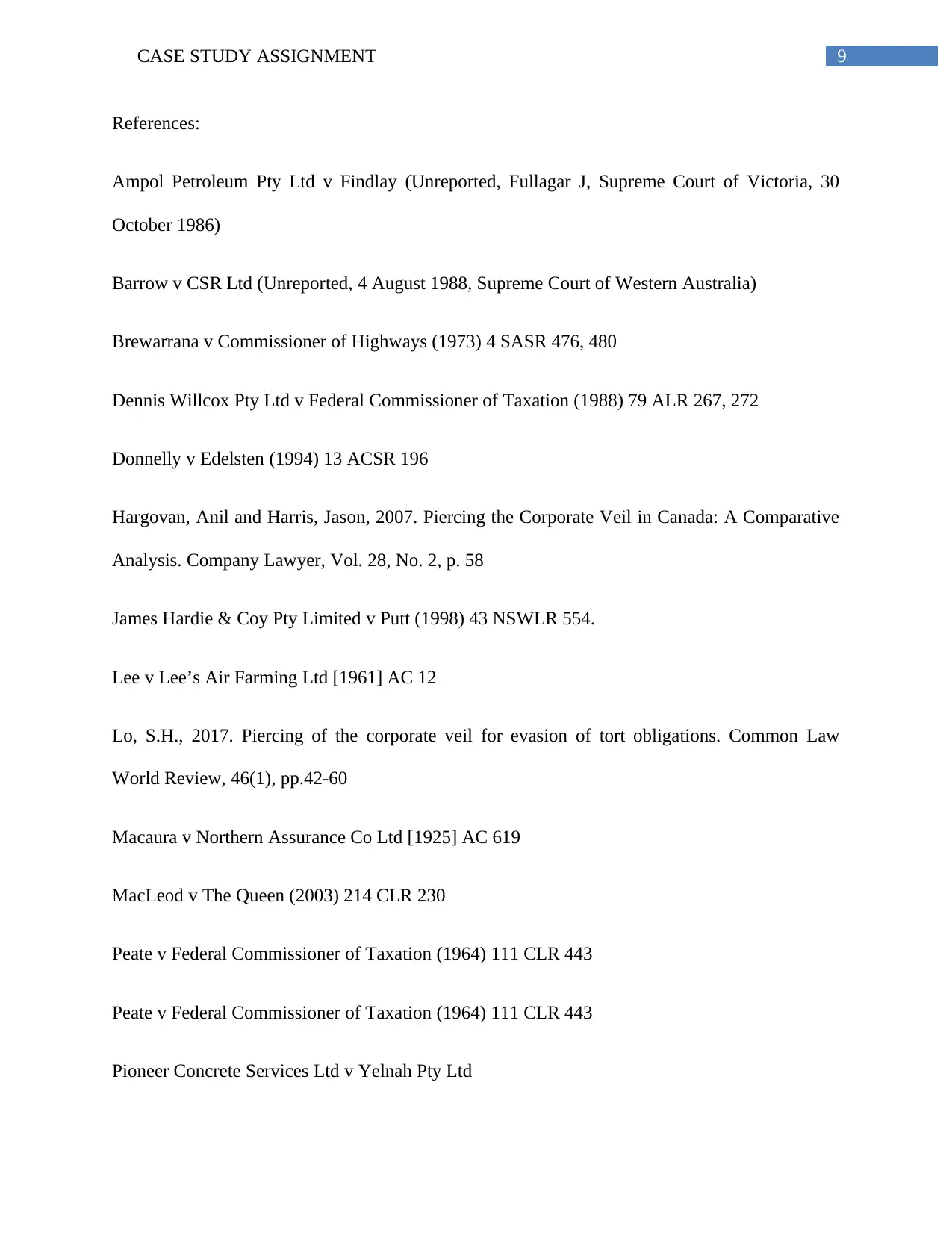
9CASE STUDY ASSIGNMENT
References:
Ampol Petroleum Pty Ltd v Findlay (Unreported, Fullagar J, Supreme Court of Victoria, 30
October 1986)
Barrow v CSR Ltd (Unreported, 4 August 1988, Supreme Court of Western Australia)
Brewarrana v Commissioner of Highways (1973) 4 SASR 476, 480
Dennis Willcox Pty Ltd v Federal Commissioner of Taxation (1988) 79 ALR 267, 272
Donnelly v Edelsten (1994) 13 ACSR 196
Hargovan, Anil and Harris, Jason, 2007. Piercing the Corporate Veil in Canada: A Comparative
Analysis. Company Lawyer, Vol. 28, No. 2, p. 58
James Hardie & Coy Pty Limited v Putt (1998) 43 NSWLR 554.
Lee v Lee’s Air Farming Ltd [1961] AC 12
Lo, S.H., 2017. Piercing of the corporate veil for evasion of tort obligations. Common Law
World Review, 46(1), pp.42-60
Macaura v Northern Assurance Co Ltd [1925] AC 619
MacLeod v The Queen (2003) 214 CLR 230
Peate v Federal Commissioner of Taxation (1964) 111 CLR 443
Peate v Federal Commissioner of Taxation (1964) 111 CLR 443
Pioneer Concrete Services Ltd v Yelnah Pty Ltd
References:
Ampol Petroleum Pty Ltd v Findlay (Unreported, Fullagar J, Supreme Court of Victoria, 30
October 1986)
Barrow v CSR Ltd (Unreported, 4 August 1988, Supreme Court of Western Australia)
Brewarrana v Commissioner of Highways (1973) 4 SASR 476, 480
Dennis Willcox Pty Ltd v Federal Commissioner of Taxation (1988) 79 ALR 267, 272
Donnelly v Edelsten (1994) 13 ACSR 196
Hargovan, Anil and Harris, Jason, 2007. Piercing the Corporate Veil in Canada: A Comparative
Analysis. Company Lawyer, Vol. 28, No. 2, p. 58
James Hardie & Coy Pty Limited v Putt (1998) 43 NSWLR 554.
Lee v Lee’s Air Farming Ltd [1961] AC 12
Lo, S.H., 2017. Piercing of the corporate veil for evasion of tort obligations. Common Law
World Review, 46(1), pp.42-60
Macaura v Northern Assurance Co Ltd [1925] AC 619
MacLeod v The Queen (2003) 214 CLR 230
Peate v Federal Commissioner of Taxation (1964) 111 CLR 443
Peate v Federal Commissioner of Taxation (1964) 111 CLR 443
Pioneer Concrete Services Ltd v Yelnah Pty Ltd
Paraphrase This Document
Need a fresh take? Get an instant paraphrase of this document with our AI Paraphraser
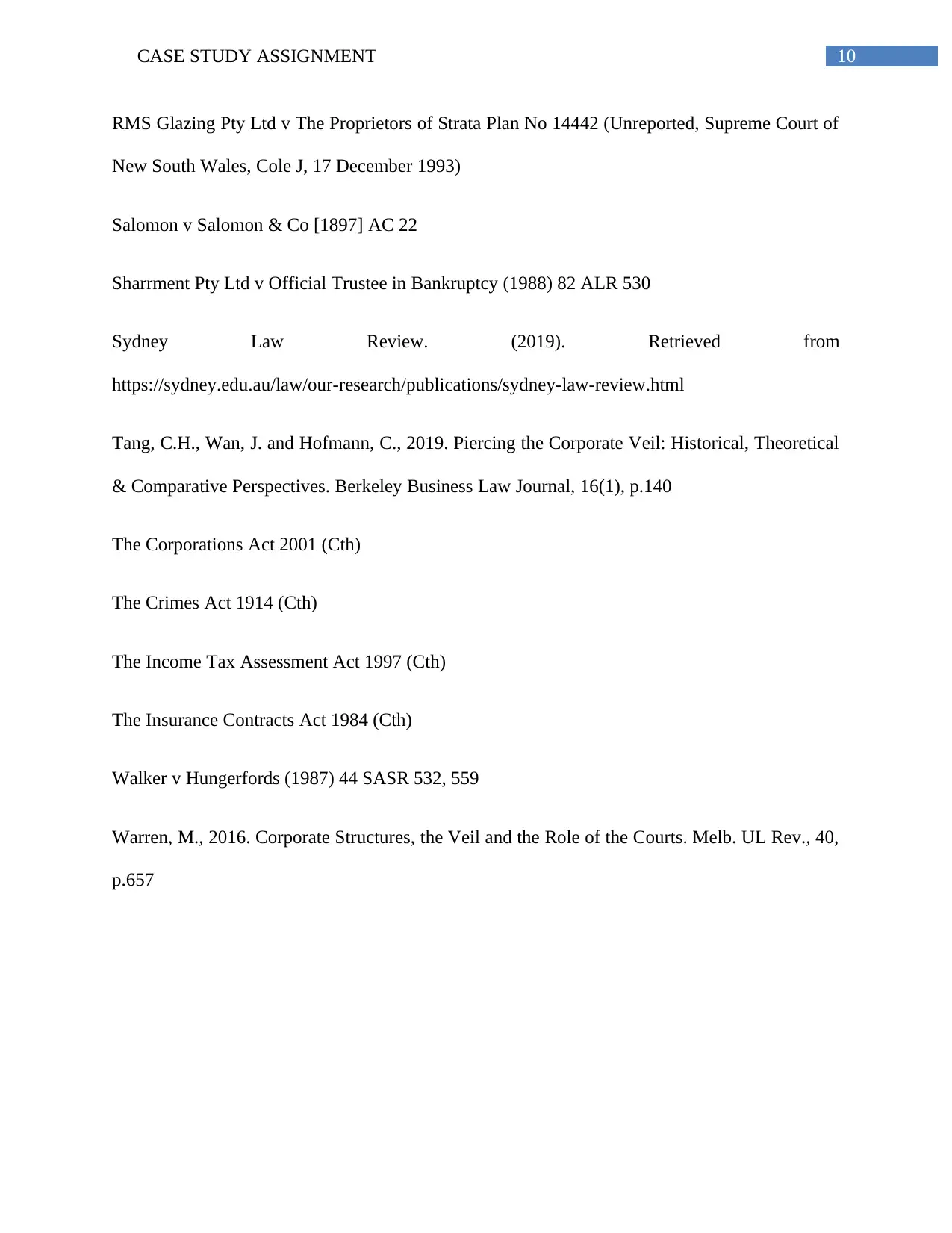
10CASE STUDY ASSIGNMENT
RMS Glazing Pty Ltd v The Proprietors of Strata Plan No 14442 (Unreported, Supreme Court of
New South Wales, Cole J, 17 December 1993)
Salomon v Salomon & Co [1897] AC 22
Sharrment Pty Ltd v Official Trustee in Bankruptcy (1988) 82 ALR 530
Sydney Law Review. (2019). Retrieved from
https://sydney.edu.au/law/our-research/publications/sydney-law-review.html
Tang, C.H., Wan, J. and Hofmann, C., 2019. Piercing the Corporate Veil: Historical, Theoretical
& Comparative Perspectives. Berkeley Business Law Journal, 16(1), p.140
The Corporations Act 2001 (Cth)
The Crimes Act 1914 (Cth)
The Income Tax Assessment Act 1997 (Cth)
The Insurance Contracts Act 1984 (Cth)
Walker v Hungerfords (1987) 44 SASR 532, 559
Warren, M., 2016. Corporate Structures, the Veil and the Role of the Courts. Melb. UL Rev., 40,
p.657
RMS Glazing Pty Ltd v The Proprietors of Strata Plan No 14442 (Unreported, Supreme Court of
New South Wales, Cole J, 17 December 1993)
Salomon v Salomon & Co [1897] AC 22
Sharrment Pty Ltd v Official Trustee in Bankruptcy (1988) 82 ALR 530
Sydney Law Review. (2019). Retrieved from
https://sydney.edu.au/law/our-research/publications/sydney-law-review.html
Tang, C.H., Wan, J. and Hofmann, C., 2019. Piercing the Corporate Veil: Historical, Theoretical
& Comparative Perspectives. Berkeley Business Law Journal, 16(1), p.140
The Corporations Act 2001 (Cth)
The Crimes Act 1914 (Cth)
The Income Tax Assessment Act 1997 (Cth)
The Insurance Contracts Act 1984 (Cth)
Walker v Hungerfords (1987) 44 SASR 532, 559
Warren, M., 2016. Corporate Structures, the Veil and the Role of the Courts. Melb. UL Rev., 40,
p.657
1 out of 11
Related Documents
Your All-in-One AI-Powered Toolkit for Academic Success.
+13062052269
info@desklib.com
Available 24*7 on WhatsApp / Email
![[object Object]](/_next/static/media/star-bottom.7253800d.svg)
Unlock your academic potential
Copyright © 2020–2025 A2Z Services. All Rights Reserved. Developed and managed by ZUCOL.





